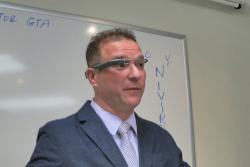  The author taking part in the Distracted Driving event with Angelo DiCicco, Young Drivers of Canada. Click image to enlarge |
Article by Lesley Wimbush
TORONTO, ON – The disembodied face suddenly appears above my right eye, like a head-up display imprinted directly on the retina. This would be merely disconcerting if this was a stationary demonstration, but since I’m currently behind the wheel of a moving vehicle, it’s having a major impact on my concentration.
The pair of Google Glass I’m trying out is the latest example of technology moving faster than our ability to adapt, or even determine the sort of legislature needed to govern it.
Human beings have only been driving for the last hundred years. But physically, our vision and multi-tasking abilities haven’t evolved beyond what we needed to see a few hundred feet ahead, while travelling on foot. Piloting a vehicle safely requires concentration and skill – throw the burgeoning level of technology and connectivity into the mix, and the potential for disaster is enormous.
Recently, we were invited to spend the day with Young Drivers of Canada in Toronto for a hands-on demonstration of some of the latest technology, and discuss its effects on driver distraction.
According to Young Drivers, driver distraction accounts for 20–30 percent of all collisions, 2,406 traffic-related deaths, 172,883 related injuries, 30 percent of all workplace fatalities – with a cost to Canada of $62.7 billion annually when you factor in emergency response, hospitalization, insurance and lost revenue due to impeded traffic flow.
“This internet thing? It’s not going away – it’s here to stay,” said Angelo DiCicco, Toronto Centre’s Director of Young Drivers of Canada.
“It’s not our job to police it, but to figure out how to adapt and be ready for it.”
Unfortunately, traffic laws governing distraction lag far behind technology. Despite all the overwhelming evidence of the dangers of cell phone use, many provinces have only had legislation in place for a few short years. Here they are, and the fines are ludicrously small.
Accompanied by an instructor, we drive a public road course with some pre-determined incidents thrown at us along the way. Most of us spotted the cyclist who pulled up beside us in the turning lane, but a few were late in seeing a man chasing a ball into the street, and stopped just short of hitting him. And these exercises took place without any additional connectivity distractions.
  Distracted Driving event at Young Drivers of Canada, Toronto Centres. Click image to enlarge |
Next, we watched a video and were asked to count the number of passes completed by two teams tossing a volleyball around. While some of us successfully came up with the right numbers – nobody in the group spotted the costumed dancing bear in the background of the video.
This is known as the “Invisible Gorilla” effect, according to Charles Shrybman, Young Driver’s Senior Regional Trainer.
“Intense focusing on a task can make you blind to your surroundings” he said. Engrossed in a cell phone conversation, we become “cognitively disengaged” and we don’t immediately recognize looming disaster. It’s not just the time lost looking at the phone – it actually takes time for the brain to switch over and process completely different tasks.
Indeed.
I’m wearing a $1,500 prototype pair of Google Glass and granted, while there are some adjustments to be made to the user interface, it’s extremely difficult to navigate the closed course behind the wheel with them on.
In the back seat, Wayne Giang, a UofT PhD student currently studying human attention as it applies to vehicle control, attempts to send me both text and visual messages with various degrees of success. The picture fades in and out, the glasses switch on and off at will, but even so, it’s easy to see that once the bugs have been worked out, Google Glass will inevitably be adopted by mainstream users. But with the glasses periodically chiming in my ear to alert me of incoming messages, the “smart watch” on my wrist buzzing in tandem, and Wayne’s disembodied head winking in and out of the tiny screen at the corner of my eye – I’m relieved that the “intersection” I’m trying to navigate is closed to other traffic.
DiCiccio estimates there are currently about 10 pairs of Google Glass in Ontario with that number likely to increase to 5,000-10,000 by the end of the year. “We need to peer into the future, the intersection of technology and driving, while it’s still malleable.”
DiCiccio suggests we could have a better understanding of our needs and how they integrate with those of others – and even more importantly – maintain our driving skills, “Working towards a co-operative driving culture is a start”.











